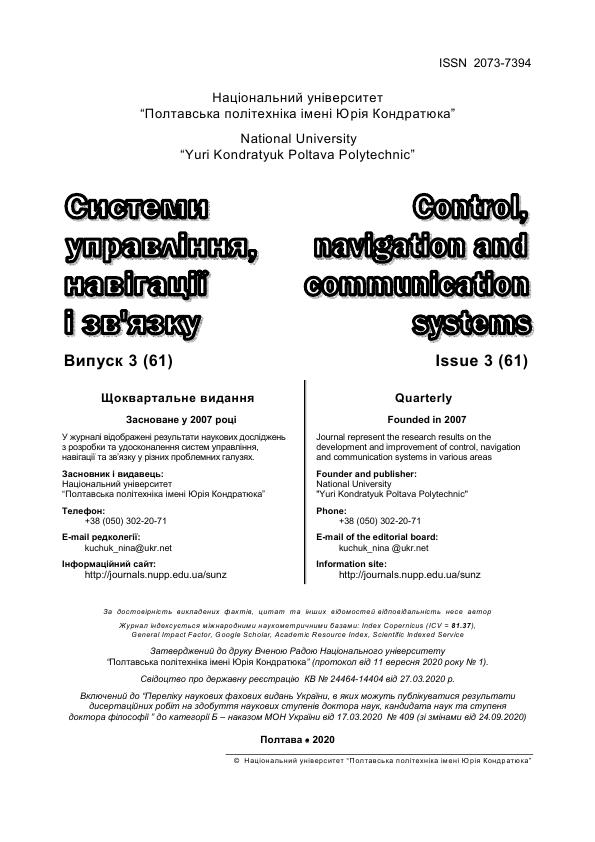МЕТОД ПЕРЕДБАЧЕННЯ ОСОБЛИВИХ ВИПАДКІВ В ПОЛЬОТІ НА ОСНОВІ ЗАВЧАСНОГО ВИЯВЛЕННЯ АНОМАЛЬНИХ ПОСЛІДОВНОСТЕЙ В ДІАГНОСТИЧНИХ ДАНИХ ТЕХНОЛОГІЧНОГО ОБЛАДНАННЯ ПОВІТРЯНОГО СУДНА
DOI:
https://doi.org/10.26906/SUNZ.2020.3.028Ключові слова:
безпека польотів, особливі випадки в польоті, параметрична діагностика, прогнозування, аномальна послідовність, часовий ряд, темпоральний патерн, гібридна стохастична модельАнотація
Сучасні бортові цифрові системи автоматичного управління, контролю і діагностики дозволяють вимірювати велику кількість параметрів технологічного обладнання повітряного судна і отримувати масиви такої інформації в цифровому вигляді. Прогнозування особливих випадків в польоті є основним завданням параметричного діагностування технологічного обладнання повітряного судна. Однак існуючі діагностичні моделі, що базуються на відповідних математичних моделях, не повною мірою використовують масиви діагностичних даних та не завжди дозволяють прогнозувати виникнення відмов технологічного обладнання, що робить задачу прогнозування особливих випадків в польоті актуальною. Мета статті полягає в розробці методу прогнозування особливих випадків в польоті на основі виявлення аномальних послідовностей в діагностичних даних технологічного обладнання повітряного судна; з метою підвищення безпеки польотів. Результати дослідження. У роботі запропоновано метод прогнозування особливих випадків в польоті на основі завчасного виявлення аномальних послідовностей в діагностичних даних технологічного обладнання повітряного судна. Для завчасного виявлення аномальних послідовностей пропонується використовувати гібридну стохастичну модель та метод виявлення аномальних послідовностей в діагностичних даних технологічного обладнання повітряного судна. Вхідна тренувальна інформація надається у вигляді векторів спостережень за розвитком процесу в яких особливо виділене кінцеве значення, в якості результату, що характеризують факти приналежності вектору до класу нормальних або аномальних темпоральних патернів. Висновок. Застосування запропонованого методу дозволить впровадити прогностичний принцип управління безпекою польотів, а також отримати економічний ефект від запобігання простою повітряного судна через раптової відмови обладнанняЗавантаження
Посилання
Yule, G.U. On a method of investigating periodicities in disturbed series, with special reference to Wolfer's sunspot numbers / G. U. Yule // Philosophical Transactions of the Royal Society of London. Series A, Containing Papers of a Mathematical or Physical Character. – 1927. – pp. 267-298.
Koskela, T. Neural network methods in analyzing and modelling time varying processes / T. Koskela et al. – Helsinki University of Technology, 2003.
Sfetsos, A. Time series forecasting with a hybrid clustering scheme and pattern recognition / A. Sfetsos, C. Siriopoulos // Systems, Man and Cybernetics, Part A: Systems and Humans, IEEE Transactions on. – 2004. – Vol. 34, No. 3. – pp. 399-405.
Esling, P. Time-series data mining / P. Esling, C. Agon // ACM Comp. Surveys (CSUR). – 2012. – Vol. 45, No. 1. – pp. 12.
Pesaran, M. H. Forecasting time series subject to multiple structural breaks / M. H. Pesaran, D. Pettenuzzo, A. Timmermann // The Review of Economic Studies. – 2006. – Vol. 73, No. 4. – pp. 1057-1084.
Wagner, N. Time series forecasting for dynamic environments: the DyFor genetic program model / N. Wagner et al. // IEEE Transactions on Evolutionary Computation – 2007. – Vol. 11, No. 4. – pp. 433-452.
Burkom, H. S. Automated time series forecasting for biosurveillance / H. S. Burkom, S. P. Murphy, G. Shmueli // Statistics in medicine. – 2007. – Vol. 26, No 22. – pp. 4202-4218.
Song, H. Tourism demand modelling and forecasting – A review of recent research / H. Song, G. Li // Tourism Management. – 2008. – Vol. 29, No. 2. – pp. 203-220.
Herrera, L. J. Recursive prediction for long term time series forecasting using advanced models / L. J. Herrera et al. // Neurocomputing. – 2007. – Vol. 70, No 16. – pp. 2870-2880.
Patcha, A. An overview of anomaly detection techniques: Existing solutions and latest technological trends / A. Patcha, J.M. Park // Computer Networks. – 2007. – Vol. 51, No. 12. – pp. 3448-3470.
Sorjamaa, A. Methodology for long-term prediction of time series / A. Sorjamaa et al. // Neurocomputing. – 2007. – Vol. 70, No. 16. – pp. 2861-2869.
Averkin, A. Time series forecasting based on hybrid neural networks and multiple regression / A. Averkin, S. Yarushev, I. Dolgy, A. Sukhanov // Proceedings of the First International Scientific Conference “Intelligent Information Technologies for Industry” (IITI’16): Volume 1. – 2016. – pp. 111-121.
Гибридная стохастическая модель обнаружения особых типов паттернов в темпоральных данных / С.М. Ковалев, А.Н. Гуда, М.А. Бутакова // Вестник Ростовского государственного университета путей сообщения. – 2013. – No3(51). – С. 36-42.




